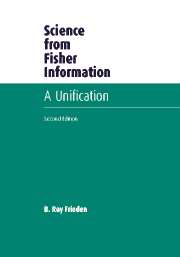Book contents
- Frontmatter
- Contents
- 0 Introduction
- 1 What is Fisher information?
- 2 Fisher information in a vector world
- 3 Extreme physical information
- 4 Derivation of relativistic quantum mechanics
- 5 Classical electrodynamics
- 6 The Einstein field equation of general relativity
- 7 Classical statistical physics
- 8 Power spectral 1 / ƒ noise
- 9 Physical constants and the 1/x probability law
- 10 Constrained-likelihood quantum measurement theory
- 11 Research topics
- 12 EPI and entangled realities: the EPR–Bohm experiment
- 13 Econophysics, with Raymond J. Hawkins
- 14 Growth and transport processes
- 15 Cancer growth, with Robert A. Gatenby
- 16 Summing up
- Appendix A Solutions common to entropy and Fisher I-extremization
- Appendix B Cramer–Rao inequalities for vector data
- Appendix C Cramer–Rao inequality for an imaginary parameter
- Appendix D EPI derivations of Schrödinger wave equation, Newtonian mechanics, and classical virial theorem
- Appendix E Factorization of the Klein–Gordon information
- Appendix F Evaluation of certain integrals
- Appendix G Schrödinger wave equation as a non-relativistic limit
- Appendix H Non-uniqueness of potential A for finite boundaries
- Appendix I Four-dimensional normalization
- Appendix J Transfer matrix method
- Appendix K Numerov method
- References
- Index
15 - Cancer growth, with Robert A. Gatenby
Published online by Cambridge University Press: 03 February 2010
- Frontmatter
- Contents
- 0 Introduction
- 1 What is Fisher information?
- 2 Fisher information in a vector world
- 3 Extreme physical information
- 4 Derivation of relativistic quantum mechanics
- 5 Classical electrodynamics
- 6 The Einstein field equation of general relativity
- 7 Classical statistical physics
- 8 Power spectral 1 / ƒ noise
- 9 Physical constants and the 1/x probability law
- 10 Constrained-likelihood quantum measurement theory
- 11 Research topics
- 12 EPI and entangled realities: the EPR–Bohm experiment
- 13 Econophysics, with Raymond J. Hawkins
- 14 Growth and transport processes
- 15 Cancer growth, with Robert A. Gatenby
- 16 Summing up
- Appendix A Solutions common to entropy and Fisher I-extremization
- Appendix B Cramer–Rao inequalities for vector data
- Appendix C Cramer–Rao inequality for an imaginary parameter
- Appendix D EPI derivations of Schrödinger wave equation, Newtonian mechanics, and classical virial theorem
- Appendix E Factorization of the Klein–Gordon information
- Appendix F Evaluation of certain integrals
- Appendix G Schrödinger wave equation as a non-relativistic limit
- Appendix H Non-uniqueness of potential A for finite boundaries
- Appendix I Four-dimensional normalization
- Appendix J Transfer matrix method
- Appendix K Numerov method
- References
- Index
Summary
Introduction
One must understand the enemy before he can be destroyed. Thus, the subject of how cancers grow is of strong current interest. This is growth both in culture, i.e., under ideal conditions (in vitro), and in the body, under less-than-ideal conditions (in situ). Consequently, a very large number of journals include the subject of cancer growth within their scope. Examples are Biometrics, Cancer Research, Cancer, the British Journal of Cancer, the European Journal of Cancer, Oncology, the Journal of the National Cancer Institute, the Journal of Clinical Oncology, and the Journal of Theoretical Biology. Other such journals are cited in the references below.
A cancer is, by definition, composed of cells that have lost the ability to function normally, but can still reproduce; in fact they do so in uncontrolled fashion. In this chapter we will be primarily concerned with finding the analytical form of the law p(t) governing in situ cancer growth. The latter is often termed carcinogenesis. (Note: For brevity, by “cancer” we will mean in situ cancer unless specified otherwise.)
Here t is a general time t after the onset time of the growth, i.e., after the instant at which an invasive cancer cell is initiated; and p represents the relative mass of cancerous tissue in an affected organ (say, the breast) at the time t. Since cancer mass density approximates that of healthy tissue, by the law of large numbers p also represents the probability that a randomly sampled cell of the organ will be a cancer cell. In this way, the cancer growth problem is recast as a problem of estimating a probability law. This allows it to be attacked by EPI.
- Type
- Chapter
- Information
- Science from Fisher InformationA Unification, pp. 392 - 413Publisher: Cambridge University PressPrint publication year: 2004



